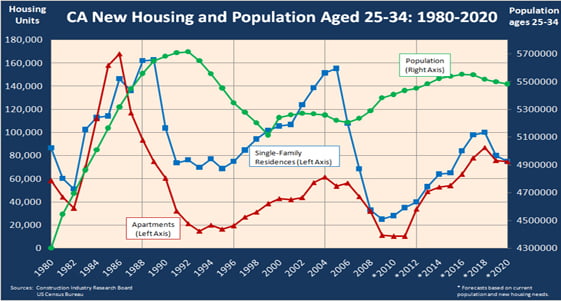Troubled balance sheet, but clean wrap-sheet
According to the California Office of the Attorney General, violent personal and property crimes have been steadily declining both before and after the recession. The violent crime rate per 100,000 citizens in 2009 was 453.6, down from 775.6 in 1983. The property crime rate per 100,000 citizens in 2009 was 1548.1, down from 3166.1 in 1983. Like today, 1983 was the first year into recovery from a significant recession, followed by an amazing six-year buildup in first-time homebuyers – the Boomers having turned 25 to 34 years of age.
However, while the crime rate has dramatically decreased across the state, the total population of the age group most likely to engage in criminal activity, the 16-24 year olds, has steadily increased during the past decade of 2000. [See CA New Housing the Population Aged 25-34; 1980-2020 chart above.]
Thus, while the volume of potential perpetrators has grown and will soon finish passing through the 16-24 age bracket towards the home-buying 25-34 age bracket, peaking in numbers toward the end of this decade, the actual crime rate has decreased.
What could account for this somewhat counter-intuitive result, and what does it mean for the California real estate market?
Though Generation Y may take longer than prior generations to settle down and pass all the milestones generally associated with achieving adulthood, as a whole, Generation Y seems to be measurably more socially responsible and criminally passive than prior generations. Over a comparative 30-year span, the Boomers behaved like thugs (burning banks for starters), while their children became saints (bound to electronic gadgets of a different sort) with a better education and greatly improved skill-sets.
This is likely the result of good childhood circumstance: Generation Y was brought up in a relatively stable and prosperous period of American history (that is, until 2008). Generation Y was economically coddled, growing up in placid suburbia and (for the most part) free of any tangible threat of war or serious deprivations. Things always got better, especially so in the urban areas. Generation Y was also born with the allure and prospect of the American Dream – government subsidized homeownership – echoing resolutely in their ear, if not their genetic makeup.
Thus, Generation Y, being more susceptible to conformist trends and convention, will make ideal (and willing) property owners – once they complete their academic training and find well-paying employment, that is. Generation Y, inculcated by the government policy pushing homeownership from the moment of birth, will peak in first-time homebuyer numbers around 2018. [See CA New Housing the Population Aged 25-34; 1980-2020 chart above.]
That will trigger an avalanche of homebuying in the years immediately preceding and following the peak, mostly in urban areas close to opportunities for professional service industry employment.
Agents anticipating the coming tide of Generation Y homebuyers will take the steps now to ensure they’re in a position to profit by the time Generation Y ascends from the recessionary doldrums. As part of their preemptive action, agents should consider relocating and operating their real estate practice in the urban areas of their communities that will likely experience the most action heading into the 2020 and beyond.
By arriving early to the contest, these agents will become highly familiar with the unique nuances of their urban market of choice, develop professional notoriety in their target area (farm) and brand themselves as local experts – all before the flood of first-time, Generation Y buyers hit the market.
This rush of 25-34 year old first-time buyers will be the shot of adrenalin California now so desperately needs – we’ll just have to be patient and stand ready to participate in growing sales and rental volume during the years building up to 2018 – as the restorative effects of youth fully rattle California real estate from its economic languor.
Editor’s note – See the upcoming Part II of this article series to learn about the role of the prime-age and Boomer demographic in California’s future real estate market.















Subject: Below an answer to end the recession / depression
This will reduce 75-85% wealth in 1% ASAP ands Save “America”
Refinance all current Mtg., to 3% = Lowering payments to 300-$500 per Lower
and this money can go to consuming =Creating Jobs ***REFIs’ must not be based
on Income or Fico but being current after 5 yrs., of a Depression -Period
Otherwise -Expect a Depression
2nd
Have IRS give Tax -Refunds to EVERYONE making less than $ 50,000
IECT., Make 10,000 – Get $40,000 refund
make 20K = 30K refund
make 30K = 20K refund
make 40K = 10K refund